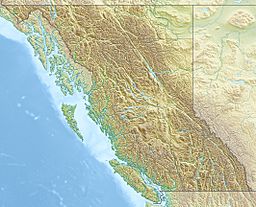Crevasse Crag facts for kids
Quick facts for kids Crevasse Crag |
|
|---|---|
| Highest point | |
| Elevation | 2,496 m (8,189 ft) |
| Prominence | 66 m (217 ft) |
| Geography | |
| Location | British Columbia, Canada |
| Parent range | Lillooet Ranges |
| Topo map | NTS 92J/01 |
| Geology | |
| Age of rock | 16 million years |
| Volcanic arc/belt | Canadian Cascade Arc Pemberton Volcanic Belt |
Crevasse Crag is a tall, pointy mountain peak in British Columbia, Canada. It's part of the Lillooet Ranges and looks very rugged. This peak is about 49 kilometers (30 miles) southeast of a village called Pemberton. Crevasse Crag stands at 2,496 meters (8,189 feet) high. It also rises 66 meters (217 feet) above the land around it.
What's in a Name?
Crevasse Crag got its name on March 31, 1969. A climber named Christian Adam suggested the name. He named it after a very large crack, called a crevasse, found just below its north side. Christian Adam and his team were the first to climb Crevasse Crag on August 16, 1967.
A Mountain with a Fiery Past
Crevasse Crag is actually what's left of an ancient, extinct volcano. It formed about 16 million years ago. This happened when the Pemberton Volcanic Belt first started to become active.
How Crevasse Crag Formed
When the volcano was active, it created different kinds of rocks. These included breccias, which are rocks made of broken pieces. It also formed tuffs, which are rocks made from volcanic ash. There were also lava flows that contained special crystals called plagioclase. All these rocks make up the mountain we see today.
Scientists have studied the rocks from Crevasse Crag. They found that the lower parts of the mountain are made of different types of lava. These include dacite, andesite, and basaltic andesite. These lava flows sit on top of older rocks. These older rocks formed from magma that pushed into the Earth's crust a long time ago.


